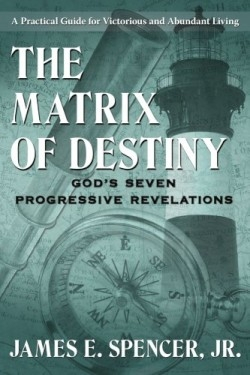The Matrix of Destiny
God's Seven Progressive Revelations
“The mission…, therefore, is to provide a powerful ‘technology’ with which to overcome the mental inertia that keeps us bound and frustrated in checking life circumstances.” This statement sums up the entire work of The Matrix of Destiny. He said that the journey he made in writing The Matrix of Destiny began 10 years before the events of 9/11 when he received “sudden enlightenment” after a friend of his was having marital problems. Mr. Spencer said that he didn’t understand how a Christian could have marital problems. Then, he had an epiphany or “sudden enlightenment”.
Matrix of Destiny is divided into four parts and within each part there are many other smaller sections. Each part contains the author’s “truth”. Many stories, anecdotes and illustrations are used to reinforce this “truth” from the author’s perspective. Charts and graphs are utilized in many of the sections such as in Part 1: Beginning at the End, where the seven important events along with his revelations are listed. While the chart helps the reader to understand the author’s point, it is a rather bland representation. Another case of a chart that attempts to add clarity to the author’s “truth” is on page 10. The chart in this case is confusing and many readers would not take the time to look at the chart and try and figure out what it is saying. Effective charts would seem to require only a quick glance at them to understand the meaning.
The author’s background is in electrical engineering and technology, and this is his first attempt at writing a serious and scholarly practical guide to spirituality. However, the audience who most likely will read this work is not the scholarly type. Most religious writers, such as F.B. Bruce, Charles Swindoll, Tim LaHaye, John Piper, and Andrew Murray, already have written works concerning the very subjects broached here. In the end, Spencer’s book doesn’t quite reach the intended goal: to add new knowledge and help people live an “abundant” life. The titles of the chapters and much of the information included are tedious and written in such a way as to be uninteresting to the average person. Maybe if the author was a recognized authority in the field of religion or an otherwise well-known author, credence to what he has written would be given. Most readers would be disappointed to find nothing original or new offered in the work.
Disclosure: This article is not an endorsement, but a review. The publisher of this book provided free copies of the book and paid a small fee to have their book reviewed by a professional reviewer. Foreword Reviews and Clarion Reviews make no guarantee that the publisher will receive a positive review. Foreword Magazine, Inc. is disclosing this in accordance with the Federal Trade Commission’s 16 CFR, Part 255.

